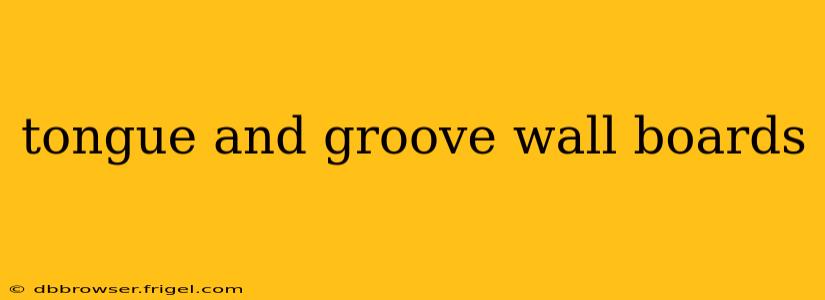Tongue and groove wall boards offer a classic and versatile solution for interior and exterior wall cladding. Their timeless appeal, coupled with their ease of installation and durability, makes them a popular choice for homeowners and builders alike. This comprehensive guide will delve into everything you need to know about tongue and groove wall boards, from their types and applications to installation techniques and maintenance.
What are Tongue and Groove Wall Boards?
Tongue and groove wall boards are planks of wood (or sometimes other materials) designed with interlocking edges. One edge features a "tongue" – a raised projection – while the other has a corresponding "groove" – a recessed channel. This ingenious design allows the boards to fit together seamlessly, creating a strong and aesthetically pleasing wall covering. The interlocking system minimizes gaps and creates a solid, stable surface.
Types of Tongue and Groove Wall Boards
Several types of tongue and groove wall boards cater to diverse needs and preferences:
-
Softwood: Commonly made from pine, fir, or spruce, softwood tongue and groove boards are affordable and readily available. They are relatively easy to work with but may be softer and more prone to dents than hardwood options.
-
Hardwood: Hardwood varieties, such as oak, maple, or cedar, offer superior durability and a more refined aesthetic. They are more resistant to scratches and dents but come with a higher price tag.
-
Engineered Wood: Engineered wood options provide a cost-effective alternative with consistent quality. These boards are often made from layers of wood veneer or composite materials, resulting in dimensional stability and resistance to warping.
What are the Advantages of Tongue and Groove Wall Boards?
The popularity of tongue and groove wall boards stems from several key advantages:
-
Aesthetic Appeal: The clean lines and natural beauty of wood create a warm and inviting atmosphere. The variety of wood types and finishes allows for customization to suit any style, from rustic to contemporary.
-
Ease of Installation: The interlocking tongue and groove system simplifies installation, making it a DIY-friendly option for many homeowners.
-
Durability: Properly installed tongue and groove wall boards are durable and long-lasting, capable of withstanding everyday wear and tear.
-
Insulation: The solid surface created by the tightly fitting boards can contribute to better insulation, helping to regulate temperature and reduce energy costs.
-
Versatile Applications: Suitable for both interior and exterior walls, ceilings, and even flooring, tongue and groove wall boards offer immense versatility in design and application.
How are Tongue and Groove Wall Boards Installed?
Installing tongue and groove wall boards typically involves these steps:
- Preparation: Ensure the wall surface is clean, level, and free from debris.
- Framing: Install framing (if necessary) to provide a solid base for the boards.
- Installation: Start from one corner, fitting the tongue of each board into the groove of the previous one. Use a mallet or rubber hammer to ensure a tight fit.
- Finishing: Once installed, the boards may require finishing touches such as sanding, priming, and painting or staining.
How Much Do Tongue and Groove Wall Boards Cost?
The cost of tongue and groove wall boards varies greatly depending on factors such as the type of wood, the board's thickness, and the overall quantity needed. Softwood options tend to be more affordable than hardwood, while thicker boards typically cost more.
What are Tongue and Groove Wall Cladding Alternatives?
Alternatives to tongue and groove wall boards include:
- Shiplap: Similar to tongue and groove, but with a more pronounced overlap.
- Vertical Siding: Offers a modern and clean look.
- Drywall: A more cost-effective but less aesthetically pleasing option.
- Vinyl Siding: Durable, low-maintenance, and available in various styles.
Can I Install Tongue and Groove Wall Boards Myself?
Yes, with the right tools and a little patience, many homeowners can successfully install tongue and groove wall boards themselves. However, for large projects or complex installations, it’s best to seek professional help.
What are the Maintenance Needs for Tongue and Groove Wall Boards?
Regular cleaning with a damp cloth will keep your tongue and groove walls looking their best. For more significant cleaning, specialized wood cleaners may be used. Periodic inspection for damage and prompt repairs will help maintain the longevity of the installation.
Conclusion
Tongue and groove wall boards offer a timeless and versatile solution for enhancing the aesthetic and functionality of any space. Their ease of installation, durability, and natural beauty make them a popular choice for both DIY enthusiasts and professional builders. By understanding the various types, benefits, and installation processes, you can make an informed decision about whether tongue and groove wall boards are the right choice for your next project.
